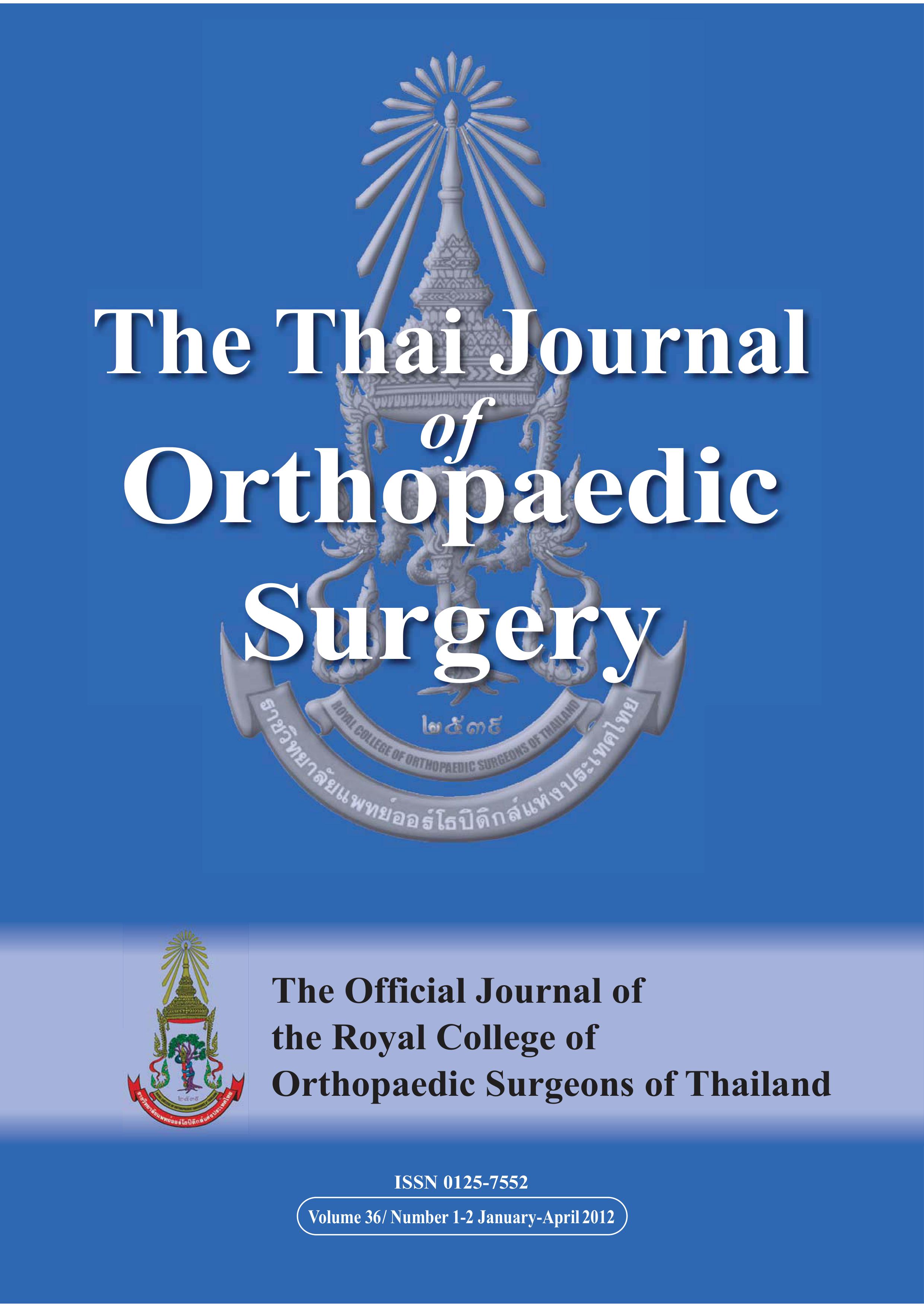Short-Segment Fixation of Thoracolumbar Burst Fracture: Plate vs. Rod Systems The Results Obtained by Adding Pedicular Screws at the Level of Fracture
Main Article Content
Abstract
Objective: To evaluate the effect of short-segment pedicle screw fixation of thoracolumbar unstable burst fractures by adding pedicle screws at the level of fracture; and to compare the pedicle plate and pedicle rod systems.
Material and Method: A retrospective study to evaluate 20 patients with unstable thoracolumbar burst fractures, admitted to Saraburi Hospital from 2006 to 2009. All underwent short-segment pedicle screw fixation with added pedicle screws at the level of fracture. A review of the medical records, including radiographs was completed. The pedicle screw fixation was classified into two types: a plate or a rod system. Evaluation was based on the correction of kyphotic deformity from the time of surgery to at least the end of a six month follow-up period.
Results: Twenty patients underwent short-segment pedicle screw fixations (8 plate, and 12 rod systems) with added screws at the level of injury. Surgical correction of kyphotic deformity from 18.4 degrees to 5.10 degrees was obtained. This was of statistical significance, and the correction maintained until fracture union, with only slightly progressive kyphotic deformity. No significant difference was encountered in the comparison of the efficacy of the pedicle plate and the pedicle rod systems.
Conclusion: Short-segment pedicle screw fixation remains popular in the treatment of thoracolumbar burst fractures. Adding pedicle screws at the level of injury results in increased stability of the system, and decreases complications. Both pedicle plate and rod systems yield similar clinical outcomes.
Article Details
References
2. Roy–Camille R, Saillant G, Mazel C. Internal fixation of the lumbar spine with pedicle screw plating. Clin Orthop Relat Res 1986; (203): 7-17.
3. Laohacharoensombat W. Ramathibodi Spinal System: Principle and Surgical Technique. 1st ed. Bangkok: Holistic Publishing company; 2001: 56-65.
4. Parker JW, Las JR, Karaikonic EE, Gains RW. Successful short segment instrumentation and fusion for thoracolumbar spine fracture: a consecutive 4 ½-year series. Spine 2000. 25(9): 1157-70.
5. Yue JJ, Sossan A, Selgrath C, Deutsch LS, Wilkens K, Testaiuti M, et al. The treatment of unstable thoracic spine fracture with transpedicular screw instrumentation: a 3-year consecutive series. Spine (Phila Pa 1976). 2002; 27(24): 2782-7.
6. Sasso RC, Renkens K, Hanson D, Reilly T, McGuire RA Jr, Best NM. Unstable
thoracolumbar burst fractures: anterior-only versus short-segment posterior fixation. J Spinal Disord Tech 2006; 19(4): 242-8.
7. Tienboon P. The Spine: Pedicle Screw Fixation Technique. 1st ed. Bangkok: DanSutha Publishing company; 2010: 84-136.
8. Enad JG, Slakey JB, McNulty PS. Measurement of thoracolumbar kyphosis after burst fracture: evaluation of intraobserver, interobserver, and variability of 4 measurement methods. Am J Orthop (Belle Mead NJ) 2008; 37(4): E60-3.
9. Khan AA, Khanzada K, Ayub S, Ali M. Surgical outcome of transpedicular fixation in thoracolumbar fractures. J Ayub Med Coll Abbottabad 2008; 20(4): 104-7.
10. An HS, Vaccaro A, Cotler JM, Lin S. Low lumbar burst fractures. Comparison among body cast, Harrington rod, Luque rod, and Steffee plate. Spine (Phila Pa 1976) 1991; 16(8 Suppl): S440-4.
11. McAfee PC, Wemer FW, Glisson RR. A biomechanical analysis of spinal instrumentation systems in thoracolumbar fractures. Comparison of traditional Harrington distraction instrumentation with segmental spinal instrumentation. Spine (Phila Pa 1976) 1985; 10(3): 204-17.
12. McLain FR, Sparling E, Benson RD. Early failure of short-segment pedicle instrumentation for thoracolumbar burst fracture: A preliminary report. J Bone Joint Surg Am 1993; 75: 162-7.
13. Sapkas G, Kateros K, Papadakis SA, Brilakis E, Macheras G, Katonis P. Treatment of unstable thoracolumbar burst fractures by indirect reduction and posterior stabilization: short-segment versus long-segment stabilization. Open Orthop J 2010; 4: 7-13.
14. Wei FX, Liu SY, Liang CX, Li HM, Long HQ, Yu BS, et al. Transpedicular fixation in management of thoracolumbar burst fractures: monosegmental fixation versus short-segment instrumentation. Spine (Phila Pa 1976) 2010; 35(15): E714-20.
15. Ahmet A, Emre A, Muharrem Y, Ali O, Adil S. Short-Segment Pedicle Instrumentation of Thoracolumbar Burst Fractures Does Transpedicular Intracorporeal Grafting Prevent Early Failure? Spine 2001; 26: 213-7.
16. Knop C, Fabian HF, Bastian L, Blauth M. Late results of thoracolumbar fractures after posterior instrumentation and transpedicular bone grafting. Spine (Phila Pa 1976) 2001; 26(1): 88-99.
17. Cho DY, Lee WY, Sheu PC. Treatment of thoracolumbar burst fractures with polymethyl methacrylate vertebroplasty and short-segment pedicle screw fixation. Neurosurgery 2003; 53(6): 1354-60; discussion 1360-1.
18. Mahar A, Kim C, Wedemeyer M, Mitsunaga L, Odell T, Johnson B, et al. Short-segment fixation of lumbar burst fracture using pedicle screw fixation at the level of the fracture. Spine (Phila Pa 1976) 2007; 32(14): 1503-7.
19. Guven O, Kocaoglu B, Bezer M, Aydin N, Nalbantoglu U. The use of screw at the fracture level in the treatment of thoracolumbar burst fractures. J Spinal Disord Tech 2009; 22(6): 417-21.


